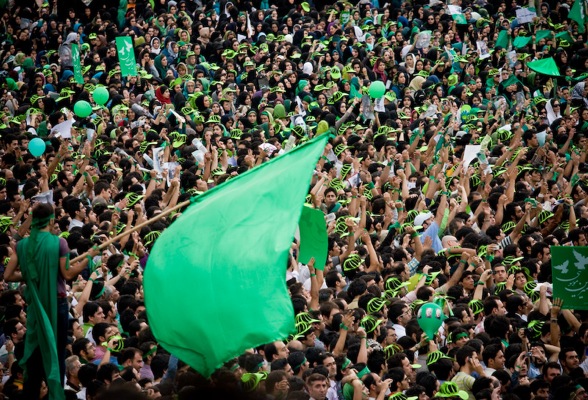Iran Analysis: "The Green Movement Has Achieved Its Goal" (Jahanbegloo)
 Iranian political philosopher Ramin Jahanbegloo, who now lives in Canada, writes for The Christian Science Monitor:
Iranian political philosopher Ramin Jahanbegloo, who now lives in Canada, writes for The Christian Science Monitor:
Celebrated in June 2009 as a model of nonviolent protest against autocracy, the Iranian Green Movement has lost much of its strength and mobilizing capacity inside Iran while the Arab Spring has toppled regimes across the region.
In Egypt, Hosni Mubarak is under arrest. But in Iran, the two defeated candidates in the disputed presidential elections of June 2009 who played such an important role in giving birth to the Green Movement --- Mir Hossein Mousavi a former prime minister, and Mehdi Karroubi, a cleric and a former parliament speaker --- are the ones under house arrest and denied any contact with the outside world. Unlike their predictions and those of many Iranian dissidents and protesters, the hardliners and especially the Iranian Revolutionary Guards Corps appeared in a far stronger position.
What happened? And where does Iran’s Green Movement stand two years later?
No doubt, the price of speaking truth to power was higher than expected for the Iranian civic actors. It resulted in massive arrests, Stalinist-style show trials, torture, rape, and murder. Also, the nature of Iran’s system, with its power split between two centers --- the president and the supreme leader --- has complicated and slowed down the process of change.
Even so, the Green Movement has achieved its goal by gaining the moral high ground, revealing to the world the true face of the Islamic regime, and draining away much of its political legitimacy. Further, it has hastened the end of Khomeinism by exposing the existent political rifts within the Iranian political power.
The current political crisis in Iran --- mainly between the president, his advisers and ministers, on the one hand, and the conservative principalists in the Majlis and revolutionary guards, on the other --- has brought the state to a standoff that is unlikely to end in a peaceful and amiable manner.
A Fracturing Regime
President Mahmoud Ahmadinejad has now made the mistake that another Iranian president, Abolhassan Banisadr, made 30 years ago when he was forced from power and had to flee into exile: challenging the political institution of the supreme leader. This time the challenge derives from the dual authority that is embedded in the Islamic Republic’s constitution.
The Iranian constitution gives predominance to sharia and authority based on the divine will, but also incorporates the will of the people and their sovereignty. It is mainly because of this dual sovereignty within the Iranian political framework and the split at the top between “quietist” clerics and “absolutists” that the republican uprising of the Iranian population emerged in the first place. The republican principle of popular sovereignty is what led presidential candidates Mr. Mousavi and Mr. Karroubi and their clerical backers, including Grand Ayatollah Yousef Sanei, to challenge Ayatollah Khamenei’s authoritarian methods of governance.
This is the first time since the revolution in 1979 that an ever-widening rift among the top clerics endangers the theory and institution of the absolute authority of the jurist as advanced by the Ayatollah Khomeini.
Thus, the fracturing of the Iranian regime hinges not only on the future of the protests but also on the forthcoming crisis for the succession of the supreme leader. The most likely scenario, unfortunately, is that the hard-line principalists, who currently occupy the key positions of power and influence around Ayatollah Khameini, are best positioned to shape the future of political power in Iran. But a range of external and internal factors could change the context in which the struggle for succession will take place.
The Struggles of the People
What preoccupies the ordinary Iranian nowadays is the deteriorating economic situation. What Iranians worry most about are rising prices and scarce jobs. Unemployment officially hovers around 11 percent, with some estimates that it will rise to 15 percent this year. According to the International Monetary Fund, Iran’s labor force is reported to be experiencing the highest “brain drain” in the Middle East. More than 180,000 highly skilled and educated Iranians leave the country every year seeking jobs in Europe and North America in order to escape Iran’s repressive environment.
Add to this a more serious test for the Islamic Republic’s energy reforms, as electricity and water bills are far less subsidized than in previous years.

 Thursday, June 16, 2011 at 7:30
Thursday, June 16, 2011 at 7:30
Reader Comments